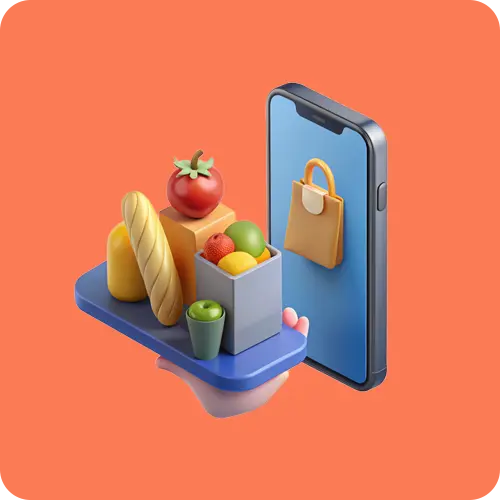“Your milk expires tomorrow, your favorite pasta sauce is running low, and you just realized you’re out of coffee.” Sound familiar? This scenario plays out in millions of households every week, but what if technology could solve this problem before it even becomes one?
Go Mart has transformed the traditional grocery shopping experience into something that feels almost magical; Behind their promise of instant delivery lies a sophisticated web of technology that anticipates your needs, optimizes every step of the process, and gets groceries to your door faster than you thought possible, so let’s pull back the curtain and explore how smart shopping really works in the digital age.

The Brain Behind the Operation: Smart Inventory Systems
Think about walking into a physical grocery store where shelves magically restock themselves just as the last item is taken; That’s essentially what happens in Go Mart’s digital ecosystem, except the magic is actually advanced inventory management technology.
The platform uses real-time tracking systems that monitor every single item across its network of fulfillment centers.
Each banana, bottle of shampoo, and bag of chips has its own digital footprint. When inventory levels hit predetermined thresholds, the system automatically triggers reorders from suppliers.
This means that popular items rarely go out of stock, and seasonal demands are predicted weeks in advance.
What makes this particularly impressive is how the system learns from customer behavior. If residents in a specific area suddenly start ordering more soup during a cold snap, the smart inventory system notices the pattern and adjusts stock levels accordingly. This predictive capability ensures that when you need something urgently, it’s almost always available for immediate delivery through services like Elite WhereGo.
Your Personal Shopping Assistant: AI-Powered Recommendations
Remember when grocery shopping meant wandering aisles, trying to remember what you needed? Go Mart’s AI recommendation engine has turned that experience on its head by becoming your personal shopping companion that actually knows you better than you know yourself.
The artificial intelligence analyzes your purchase history, seasonal patterns, and even factors like local weather or upcoming holidays to suggest items you might need, so if you typically buy fresh herbs every two weeks, the system will gently remind you when it’s time to restock.
Planning a dinner party? The AI notices increased quantities in your cart and suggests complementary items you might have forgotten.
This smart shopping technology extends beyond basic recommendations. The system recognizes relationships between products that might not be obvious. Customers who buy gluten-free flour often need xanthan gum, those purchasing fresh salmon might want lemon and dill, and families buying school supplies in August probably need lunch box snacks too.
Lightning-Fast Fulfillment: Automated Dispatch Systems
The most visible part of Go Mart’s technology magic happens in those final moments between order confirmation and delivery.
Their automated dispatch system orchestrates a complex dance of logistics that would make a symphony conductor jealous.
When you place an order, multiple systems spring into action simultaneously. The inventory system confirms product availability, the AI calculates the optimal picking route through the fulfillment center, and the dispatch algorithm identifies the best delivery driver based on location, current workload, and estimated travel time.
The automated routing system considers factors humans might miss.
Traffic patterns, construction zones, apartment building access codes, and even individual driver preferences are all factored into delivery assignments, and if a driver is particularly good at navigating a complex apartment building, the system remembers this and assigns future deliveries there accordingly.
Real-time tracking keeps everyone informed throughout the process. Customers can watch their order progress from “picking” to “on the way” to “arriving soon,” while drivers receive optimized routes that automatically adjust for traffic or new orders.
The Human Touch in Digital Shopping
Despite all this sophisticated technology, Go Mart hasn’t forgotten that grocery shopping is ultimately about people. The platform’s design philosophy centers on making technology invisible while making the experience delightful.
Customer service representatives have access to the same AI insights that power recommendations, allowing them to provide personalized assistance when needed.
If someone calls about a missing item, the rep can instantly see purchase patterns and suggest suitable substitutions, and this combination of human empathy and technological efficiency creates service experiences that feel both personal and professional.
Looking Forward: The Future of Smart Shopping
Go Mart’s current technology is impressive, but they’re already working on the next generation of smart shopping innovations. Predictive ordering might soon allow the system to automatically order staples like milk or bread when you’re running low, with your permission of course. Computer vision technology could help shoppers verify produce quality before it leaves the fulfillment center.
The grocery delivery landscape continues evolving rapidly, with platforms like Elite WhereGo leading the charge in bringing these innovations to customers across different markets. As technology advances, the line between convenience and necessity continues to blur.
Smart Shopping Is Here to Stay
The combination of intelligent inventory management, AI-powered recommendations, and automated dispatch systems has transformed how we think about getting food from farms to our tables. As more people experience this level of convenience and personalization, traditional grocery shopping methods are beginning to feel as outdated as using paper maps for navigation.
The smart shopping revolution is still in its early days, but platforms like Go Mart are proving that technology can make our daily lives genuinely better without compromising the personal touch that makes shopping enjoyable. The future of grocery delivery isn’t just about speed – it’s about creating experiences so seamless that they feel like magic, even when we know it’s just really good technology working behind the scenes.
